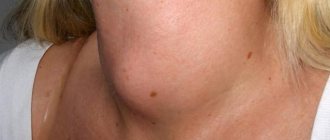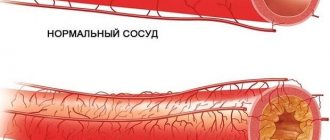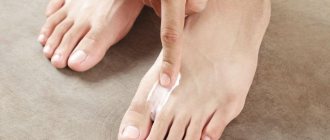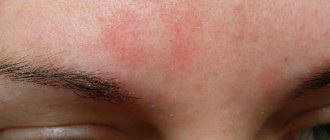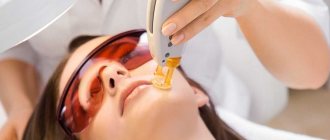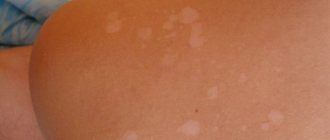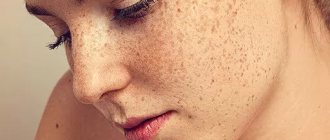Age spots are dark spots that range in color from light brown to dark brown. They appear for several reasons, including: the effects of sunburn, age-related changes, abuse of cosmetics, hormonal changes, side effects from medications.
Typically, age spots are considered an aesthetic defect. In most cases, age spots cause dry skin, increased wrinkles and dilated blood vessels. Although age spots are not malignant neoplasms, they serve as an excellent camouflage for the latter (since it is almost impossible to see a neoplasm in the area of an age spot with the naked eye).
Many people try in different ways to get rid of age spots , in this article we will look at: types of age spots, methods of getting rid of them, the need to consult a doctor (in this case an endocrinologist), the effectiveness of procedures and contraindications.
- Exposure to ultraviolet rays
- Using phototherapy
- Indications
How is it formed
Every person from birth has a genetically determined skin color - the so-called permanent pigment.
When exposed to external and internal factors, an additional one is produced, which can be either a temporary physiological phenomenon (natural tanning) or a pathological one, difficult to remove even with special lasers (lentigo, vitiligo, etc.). The formation mechanism itself occurs in the epidermal layer. Here are located keratinocytes - epidermal cells. Their life cycle is up to 60 days, so they are constantly updated. To protect young and vulnerable cellular structures from sun exposure, melanocytes exist. They belong to the nervous system and are called upon to produce melanin, which absorbs ultraviolet radiation.
If the body is healthy, there is no overdose of solar radiation, melanocytes will produce a sufficient amount of protection. However, if there are failures, the “protectors” begin to be distributed unevenly, which leads to the formation of hyperpigmented areas.
What groups of ingredients are used to lighten skin?
Representatives of these groups should be sought in the compositions of combination drugs.
- Tyrosinase inhibitors – azelaic acid, arbutin, flavonoids, resveratrol .
- Destruction and reduction of melanosomes: niacinamide, soy extracts .
- Inhibition of DOPA and dopaquinone synthesis: kojic acid.
- Exfoliation of the stratum corneum: AHAs and retinoids.
- Stimulation of the conversion of melanin to leukomelanin: vitamin C, E and glabridin.
Summary : to effectively lighten pigmentation and reduce the likelihood of side effects, it is more advisable to use combined preparations containing ingredients from different groups.
Causes of hyperpigmentation
An increase in melanin production can be associated both with physiological changes occurring in the body and as a result of pathologies. The most well-known factors influencing the occurrence of stains are:
- endocrine diseases;
- hormonal changes during pregnancy or menopause;
- diseases of the gastrointestinal tract and adrenal glands;
- metabolic disorder;
- vitamin deficiency or hypervitaminosis;
- helminthic infestations;
- severe intoxication of the body;
- trauma or inflammatory processes;
- prolonged exposure to the sun;
- taking medications - antibiotics of the tetracycline group, gentamicins, erythromycins, as well as some NSAIDs, salicylic acid, antidepressants, diuretics, sleeping pills and sedatives, antihistamines, St. John's wort extract, etc.;
- heredity.
Changes can also appear due to prolonged stress. Since melanocytes belong to the nervous system, any fluctuations and unstable conditions lead to serious pigmentation disorders.
Main reasons
If age spots from the sun appear on the face, many are interested in what helps, what to treat and what to do, but first of all you should find out what caused them.
I Heredity
This is the most common option. Even our distant ancestors often found their relatives based on similar characteristics. Information is recorded in the DNA code and passed from parents to children.
II Disorders due to hormonal changes
The dermis is not only the largest organ of the human body, but also completely dependent on hormones. Primarily sex hormones - estrogen and testosterone, as well as those produced by the pituitary gland - adrenocorticotropin, thyrotropin and somatotropin. When exposed to ultraviolet rays, they initiate a chain reaction, resulting in an unsightly dark area.
What makes the problem worse
- Taking a variety of drugs that affect hormones, including contraceptives.
- Processes during menopause.
- Pregnancy and lactation.
- Phases of the ovulation cycle in women.
- Teenage "hormonal storm".
III Diseases
Often, our epidermis becomes an indicator of health, which many simply do not pay attention to, and then think about how to remove and how to quickly remove age spots from the face, and what kind of cleansing is more suitable. Diseases that have prerequisites for the appearance of spots:
- Bacterial as well as viral infections.
- Endocrine pathologies (hypothyroidism, diabetes of any type, etc.).
- Kidney failure.
- Fungi.
- Diseases of the gastrointestinal tract and liver.
- Hypovitaminosis, hypervitaminosis.
- Violation of metabolic processes.
- Parasites.
- Sexually transmitted diseases and AIDS.
IV Peeling and other cosmetic procedures
Sometimes some manipulations for “beauty enhancement” can also affect the appearance of pigments. There are several prerequisites for this: injury or stimulation of inflammation. Therefore, it is extremely important to first diagnose the nature of the spots and only then contact a cosmetologist.
V Acne
Experts say that even the slightest mechanical damage can cause the development of pigmentation. If you squeeze out a pimple, the stratum corneum will inevitably be damaged. If you do not protect it with anything and do not use restorative agents, then it is likely that a small brown area will remain there.
Localization of spots
They can have different sizes, both with clear contours and blurry ones, merge together or not grow at all. Depending on the differential diagnosis and the type of hypermelanosis, they can be located both in certain areas and without specific boundaries, covering absolutely any area of the body.
On the face
One of the most common sites of localization of many hyperpigmentations. This is due to the fact that the skin here is thin enough so that negative factors can attack them faster. Among the common phenomena are freckles, which can decorate the face all year round and also appear and disappear after exposure to the sun. They are also localized over the entire surface or located pointwise in the area of the cheeks, eyes, and forehead.
Anti-age drugs
Bb Laboratories – Delicate oil for deep cleansing
Laennec – solution for injection
Bb Laboratories – Two-phase serum concentrate
Two-phase placental serum concentrate
On the body
Namely on the arms, shoulders, chest, back, groin area. For each individual disease, there are areas where pigment accumulation is observed. For example, senile hyperpigmentation is typically located on the hands, forearms, and upper back.
How to get rid of dark spots on your face using natural acids
In order to make the skin lighter, the following types of acids are used in cosmetology:
Boric acid for dark spots
In nature, boric acid is present in the form of the mineral sassolin in hot springs and health resorts. This substance effectively eliminates inflammatory processes, accelerates blood circulation and relieves pain, therefore an alcohol solution of boric acid is one of the most common disinfecting, healing, anti-cold and anti-rheumatic agents. However, boric acid can also help those who want to get rid of dark spots at home.
It is known that when this substance is applied to a dark area of the skin on a regular basis, it helps to inhibit the activity of melanocytes and promote melanin from the deep layers to the surface. At the same time, it is not recommended to smear your face every day with an alcohol solution of boric acid, even a weak one (2-3%), especially if the age spots occupy a significant area. It would be more correct to add the solution to natural whitening masks: one teaspoon of boric alcohol greatly increases the effectiveness of lemon or cucumber.
The most effective whitening masks with boric acid:
- One cucumber must be peeled, cut into small cubes, add half a teaspoon of an alcohol solution of boric acid, mix everything and apply to the face for 10-15 minutes. Or you can wrap the mask in gauze and apply it to the age spot.
- Prepare a medicinal composition for use in a course: you need to pour one glass of crushed oatmeal into a glass jar, pour in a glass of 3% boric alcohol, stir, cover and let it brew at room temperature for 12 hours. Then put the resulting mixture in the refrigerator. Every morning use 1 tbsp. l. mass: dissolve it in boiled water to the desired consistency and apply to age spots for 15–20 minutes.
- An excellent tonic for dark spots on the face can be obtained from freshly squeezed lemon juice and 2% boric alcohol, which must be mixed in equal proportions. Store it in the refrigerator and wipe your face every day, morning and evening, for two weeks.
Salicylic acid for dark spots
Salicylic acid helps eliminate dark spots left behind by acne and pimples, and at the same time prevent the formation of new inflammations. It has a keratolytic (exfoliating) effect on the skin, removes melanin to the upper layers of the skin and euthanizes melanocytes.
Salicylic acid is used in almost all known whitening creams and gels against acne. It is also used for salon chemical peeling and can be used at home to eliminate dark spots and treat acne. Buy a weak alcohol solution (1-5%) from the pharmacy and apply to the pigmented area using a cotton pad for 10-15 minutes, and then rinse completely with cool water.
Azelaic Acid for Dark Spots
This natural substance is obtained from wheat, rice and barley. Azelaic acid is also produced in small quantities by our skin cells, which is necessary for regulating the functioning of melanocytes. It neutralizes the synthesis of tyrosinase, the main enzyme involved in melanogenesis.
This acid has the most powerful effect on active cells - melanocytes, which is why it copes well with newly formed pigmentation, which is hormonal in nature. A substance with a 20% concentration is a component of the well-known Skinoren ointment. Using this product at home to combat dark spots is very simple and convenient: you just need to apply it to pigmented areas of the skin twice a day.
Kojic Acid for Dark Spots
Another natural tyrosinase inhibitor is kojic acid, which is a waste product of penicillin fungi and aspergillus. Its effectiveness is significantly higher than that of azelaic acid, but it can cause allergies. In addition, this is an unstable chemical compound that is destroyed by ultraviolet radiation.
In cosmetics, kojic acid is contained in the form of a more complex but stable substance - kojic acid dipalmitate in a concentration of 1-4%. If this substance is included in a whitening cream, you can safely count on its high effectiveness in the fight against freckles, chloasma, lentigo and dark spots on the face.
Glycolic Acid for Dark Spots
This is the most well-known component of salon chemical peels, along with salicylic acid. Glycolic acid is isolated from sugar cane or synthesized artificially. It lightens age spots, activates collagen synthesis, and perfectly cleanses the skin of dead cells. Therefore, cosmetologists recommend it to older women who want to eliminate dark spots on their faces.
Using 30% gel with glycolic acid on a regular basis helps smooth out fine wrinkles, regenerate skin and normalize complexion. At home, the procedure time should not exceed 10 minutes. Glycolic acid should be used no more than twice a week, and the day after the procedure you should avoid bright sun and do not use serums with hyaluronic acid.
Read material on the topic: How to care for facial skin: home care and salon treatments
Types and symptoms of age spots
Let's consider the most characteristic signs of hypermelanosis, as well as control methods that are relevant for each specific type of pathology.
Freckles
The most common type of melanin accumulation. They are mainly located on the face, in the cheek area. In advanced cases, they can completely cover the entire surface of the skin with small distances between the spots. And also have a round or oval shape, small diameter, clear contours.
Genetic predisposition plays a major role, so freckles can appear in childhood. People with red and blond hair are most susceptible to them. This is due to the need for high melanin production to protect the skin.
Freckles can be easily distinguished from other types of spots by the complete disappearance of pigmentation in cold weather, and the appearance of a whole scattering on the face with the arrival of warmth. Therefore, to combat them, creams with maximum sun filters are used throughout the year, as well as lightening cosmetics.
Melasma
Spots without clear boundaries and endings, varying in shade from bronze to dark brown. They have the ability to stretch, grow, and merge with each other into huge pigmented areas that occupy a large surface of the body. The main provoking factor is considered to be hormonal disorders caused by menopause, pregnancy, and the use of oral contraceptives. Treatments include peeling methods and procedures that promote cell renewal. When the root causes are eliminated, the stains quickly disappear.
Melasma
The second name is melanosis. It can be acquired or hereditary, manifests itself in the form of an accumulation of melanin with uneven but clear boundaries and localization in open areas of the body. May occur as a result of Addison's disease, hemochromatosis, due to sensitivity to ultraviolet radiation, anthracene or acridine substances, diseases of the pituitary gland, ovaries, adrenal glands, syphilis, tuberculosis, malaria, treatment with hormones. Pigmentation is accompanied by redness, itching, peeling, and roughening of the skin.
To prevent progress, sunscreens are used, drug therapy is prescribed with steroid groups, retinoids, hydroacids, and vitamins B (1.6) and C are additionally used.
Becker's nevus
A characteristic defect in men, it is much less common in women. The first manifestations can be as early as 10 years of age. It is a hyperpigmented area protruding above the surface of the skin, on which dark long hairs grow. It occurs both as a result of genetic factors and can appear after sun exposure, changes in hormonal levels, in particular androgens. The location most often is the upper back and chest; it is not often found on the legs, groin, or head. It has a warty surface on which acne or comedones can be seen. Does not respond well to any cosmetic procedures or medications. An argon laser is used to minimize the aesthetic defect.
Secondary
Occurs at the site of mechanical damage. They can be either deep cuts, scratches, or acne, comedones, ulcers and other superficial causes that trigger the inflammatory process in the skin cells. There is an excess of melanin, resulting in staining. They are localized where the damage was and go away after the area returns to normal and the inflammation disappears. To speed up the lightening process, you can use special lightening creams or cosmetic procedures aimed at renewing the epidermal layer.
Age
As we age, the negative effects of ultraviolet radiation lead to increased melanin production in certain areas of the body. These are usually open areas that have been exposed to a lot of sunlight during their lifetime. With age, spots appear with a diameter of 1 to 5 cm, which are darker in color than the entire surface of the skin.
Berlocc's dermatitis
Refers to contact types of immune response to irritants. Usually due to contact with perfumes, colognes, and deodorants. It is located where the skin came into contact with the substance. Symptoms may include not only a change in the color of the dermal layer, but also itching, peeling, and swelling. It disappears quickly, just stop using perfume and in a few days everything will return to normal.
Chloasma
Large spots can merge into one large skin defect. They do not have a clear contour or boundaries and can grow and increase in size throughout life. Among the provoking factors are pregnancy and lactation, menopause, changes in hormonal levels due to diseases, stress, taking oral contraceptives, steroids, the use of hormone-containing ointments and some cosmetics.
How to prevent the appearance of age spots?
If the cause of pigmentation does not lie in a hereditary factor, a cosmetic defect can be avoided. Preventive measures:
- do not develop diseases of internal organs - be sure to undergo routine examinations with doctors twice a year;
- do not get carried away with tanning - both in the sun and in the solarium;
- take care of skin protection - go outside in winter, after applying cream with SPF 30, in summer the indicator should be 50;
- choose wisely skincare products to maintain a beautiful and even skin tone;
- maintain a drinking regime - do not let the skin dry out;
- monitor hygiene, prevent the development of acne and the formation of comedones;
- control hormonal levels.
It is also important to take care of prevention long before the period of wilting. The sooner sufficient attention is paid to care and protection, the later the skin will undergo age-related changes. Pigment spots are a phenomenon that can and should be combated. Don’t give up if home treatments don’t bring results; you can always turn to a cosmetologist for help.
What causes pigment spots to appear on the face after sunbathing?
Most manifestations of hyperpigmentation occur after the negative effects of ultraviolet rays. Among those that immediately appear are freckles, various melasma and chloasma. There are also those that have a cumulative effect, for example, lentigo.
Also, if during the summer vacation there were inflammatory processes in open areas of the body, most likely after they heal, a change in shade can be clearly observed.
Prolonged exposure to the hot sun with the presence of existing tumors and increased pigmentation can be fraught with the degeneration of harmless spots into aggressive cancer - melanoma. Therefore, you should limit your tanning time and use special cosmetics for protection.
Important!
In a beauty salon, pigment spots that have formed from ultraviolet rays are removed. Sometimes pigmentation appears as a result of internal changes in the body. This may be due to gynecology, cholecystitis or intestinal dysbiosis. In this case, the cosmetic procedure will relieve stains only for a short time. A preliminary examination will allow you to achieve a longer lasting result.
It is better to undergo the pigmentation cleaning procedure in autumn or winter. It is important that the sun does not fall on your face after the procedure. Otherwise, the skin will turn white and the spots will remain forever. After the procedure, you need to carefully monitor your face. The skin should be lubricated with sunscreen several times a day. If you ignore regular care, you will have to make another appointment with a cosmetologist. There is a high risk of getting even more age spots.
Age spots and peeling
Melanin accumulation occurs in the upper layers of the epidermis. In order to remove unaesthetic problems, products that stimulate the renewal of the dermis are used. The most effective peelings are: chemical, mechanical, laser. They promote the regeneration of epidermal cells, forcing keratinocytes to produce new ones as quickly as possible, which will not have a large accumulation of coloring pigment. When eliminating the root causes of hyperpigmentation, there is a chance that you will forget about various spots for a long time.
Causeless manifestations
It happens that people try to protect their skin, use special sunscreens, but hyperpigmented areas still appear. It's like it happens for no apparent reason. However, for melanocytes to malfunction, even a small but prolonged stress or temporary hormonal imbalance is enough.
It is also worth noting the cumulative negative effect of ultraviolet radiation, which can manifest itself over the years on areas of the body that received sunburn in early childhood. Therefore, only at first glance it seems that hypermelanosis arose without provoking factors. In fact, he has hidden reasons.
In men
The stronger sex may also well suffer from such a common problem, but its prerequisites are somewhat different:
- Sensitive and excessively thin dermis.
- Genetics.
- Neuroses, constant stress.
- Excess estrogen.
- Lack of minerals and vitamins.
- Age over 45 years.
- Smoking, drinking alcohol, hazardous work conditions.
Some of the reasons naturally overlap with “female” ones.
Liver pigment spots
Deterioration in the functionality of internal organs can also lead to the formation of aesthetic defects. The liver plays the role of a filter, retaining and processing all dangerous substances, and then removing them from the body. In cases where she fails to cope with her duties, slow but sure intoxication occurs, which is manifested not only by internal, but also by external pathologies.
Metabolic processes in tissues are disrupted, including the normal distribution of melanin; it accumulates in certain areas. Most often it appears on the face. The contours of such spots are not uniform, they do not have a clear boundary. The color can also vary from light to dark brown.
Causes of age spots on the hands after 40, 50, 60 years
Women after 40, 50, 60 years old often develop pigment spots on their hands - the so-called age-related lentigines. But their real reason is not the number of years you have lived, but the number of photodamages that you have accumulated throughout your life.
After all, the sun leaves a mark on your skin every day, every minute during daylight hours, starting from your infancy. And this ultimately affects the work of melanocytes and the accumulation of melanin.
In 9 out of 10 cases, the main cause of age spots on the hands is ultraviolet radiation. And the older you are, the higher the likelihood of this problem occurring.
Plus, menopause and hormonal fluctuations also make themselves felt.
Another extreme option is possible - frostbite on the hands. Because of it, pigmentation may decrease over time, which will manifest itself in the formation of white spots.
Lentigo
The phenomenon is popularly known as “senile ripples.” Appears in older people in areas of the body that have been exposed to intense ultraviolet rays throughout their lives. The pigment usually appears on the arms from the hands to the top of the shoulders, upper back, décolleté, and face. It is distinguished by its small size, different diameters and chaotic arrangement of spots.
The first manifestations can be noticed after 40 years; they noticeably age the appearance, so many people at this stage turn to cosmetologists to eliminate the defect. During menopause, hormonal changes lead to an increase in the amount of pigment. Chemical, mechanical and laser peels are used for treatment. Cosmetics and whitening creams will not cope with the problem.
Treatment
Age spots are not an independent disease, but a symptom. Therefore, before treating pigment spots that have arisen, it is necessary to find out the cause of their formation, and for this you will have to undergo examination by a gynecologist, endocrinologist, gastroenterologist and neurologist. Treatment begins with treating the underlying disease, and only then does it make sense to begin to discolor spots and eliminate skin defects.
Among the methods for eliminating age spots, the following are currently widely used:
- laser removal. This is one of the most effective and harmless ways to get rid of age spots.
- chemical peeling, which is effective only on superficial stains;
- photoremoval (photorejuvenation);
The treatment option must be determined by the doctor, since only a specialist can, taking into account the characteristics of the skin and the condition of the patient’s body, identify all possible contraindications.
Find out the cost
Solarium - is it harmful?
It is also a mistake to think that sun tanning is harmful, and nothing will happen in specialized salons in a few minutes. On the beach, the skin gets a lot of heat, but this happens gradually. In the booths, a loading dose of ultraviolet radiation is given in a few minutes, which is difficult to obtain outdoors even in a whole day.
People with a fair skin type, with the presence of moles and nevi, freckles, existing aesthetic defects in the form of increased melanin production, need to get rid of the habit of visiting a solarium. The consequences can be expressed both in the progression of unsightly changes in the epidermal layer, and in their degeneration into malignant neoplasms.
Features of aging hands
Have you heard the banal phrase that hands are the first to reveal a woman’s age? Alas, this is the bitter truth.
Look at the celebrities. If the age on the face can be hidden behind makeup, “beauty injections” and braces, then the hands will reveal it instantly. These wrinkled “chicken feet” with age spots literally scream that the young star is no longer fresh. And, most likely, she is interested in artificial “rejuvenation” rather than natural. If you prolong your youth by activating natural physiological mechanisms, this can be seen both in your face and in your hands. And here the face is not organic, and the hands are old. You can't hide the truth.
But first things first.
Why do hands age faster than your face?
- They are most susceptible to the influence of negative external factors.
In summer, the hands are always exposed to the sun; in winter, they often become hypothermic. And what is the cost of constant contact with household chemicals and mechanical impact! How often do you wash dishes, clean plumbing, do wet cleaning, soak stains, do laundry? Do you always wear gloves? Here is the answer. - The skin of the hands differs in its anatomical structure from the skin of the face.
It has fewer sebaceous glands, which means less lipids are produced that protect against negative external factors. And those lipids that exist are constantly washed away and “corroded” by numerous household chores.There is also lower blood circulation in the skin of the hands. And the vessels give strength, renewal, resistance to external negative factors. The less developed microcirculation, the faster the skin fades.
- We pay less attention to our hands than to our face.
As a rule, we leave taking care of them for later.
Diagnostics
To accurately determine the type of hypermelanosis, as well as to identify effective means of control, you need to contact a dermatologist. At the initial visit, the doctor will collect the patient's medical history to determine the most likely internal and external factors that will indicate a certain type of disorder. He will examine the skin and also prescribe a number of tests:
- AOK and OAM;
- blood biochemistry;
- Wood's lamp tests;
- scraping;
- biopsy.
If a malignant neoplasm or fungal infection is suspected, referrals will be given for the last two procedures on the list. As a result, the specialist will be able to accurately determine the type of illness and prescribe therapeutic or cosmetic procedures.
Anti-age drugs
Bb Laboratories – Hyaluron-elastin-collagen extract
Laennec – solution for injection
Curacen Essence (20 fl x 2 ml)
Two-phase placental serum concentrate
How to fight
Among the modern and effective methods of struggle, it is worth highlighting:
- cosmetic preparations;
- laser peeling;
- phototherapy.
Depending on the variety, medications may be prescribed to address the underlying causes. However, to remove an aesthetic defect, it will be necessary to wait for the cell surface to renew itself, or to help it renew itself faster with the help of additional deep peeling and cosmetic photorejuvenation procedures.
Cosmetic preparations
Among the popular drugs that give noticeable results in the fight against hyperpigmentation are placental products with a high content of natural peptides, amino acids and hyaluronic acid, as well as vitamins, micro- and macroelements. Injection product Curacen (Curasen) and non-injection drug Curacen Essence (Curasen Essence) are the ideal choice of cosmetologists for triple action: brightening, moisturizing and eliminating wrinkles. You can also use specialized cosmetics from the Laennec Skincare brand - LNC. This line offers to transform the skin at the cellular level, eliminating and preventing hyperpigmentation.
Now you know about the main causes of pigmentation, as well as what causes the appearance of age spots on the face, and you can easily answer the question - what to do when pigments have already appeared. Dermatologists recommend not only limiting time spent on the beach and using sunscreen in summer, but also year-round use of skin protection from the negative effects of ultraviolet radiation. It is this that becomes the main catalyst, and in combination with internal disorders of the body can lead to serious changes in the epidermal layer.
Which method of removing age spots should I choose?
Modern cosmetology offers a wide selection of products and techniques for restoring a uniform and radiant complexion. How to remove pigment spots should be decided by the doctor after a preliminary examination of the patient. Self-administration of aggressive drugs can cause the development of difficult-to-treat side diseases that aggravate chronic diseases.
At the moment, the most effective method is laser removal of age spots. The main reasons for this choice are a less painful procedure, a quick and predictable result, the absence of foreign bodies in the skin tissue (unlike injection methods), and quick rehabilitation (thanks to a gentle regimen).
If you can’t decide on a method for removing age spots, start with laser.

